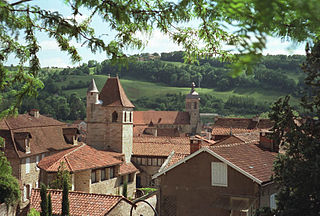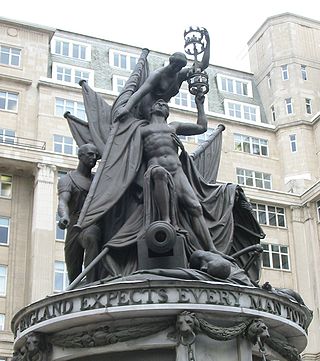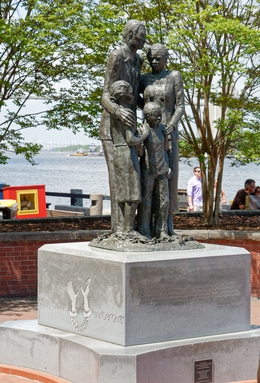
Figeac is a commune in the Lot department in south-western France. Figeac is a sub-prefecture of the department.

The Soldiers and Sailors Monument is a monument erected in Boston Common in downtown Boston, dedicated to soldiers and sailors of the Commonwealth of Massachusetts who died in the American Civil War. Designed by Martin Milmore, construction began in 1874 and the monument was dedicated on September 17, 1877. Union Generals George B. McClellan and Joseph Hooker were among the estimated 25,000 people attending the dedication on Boston Common.

The Nelson Monument is a monument to Admiral Horatio Nelson, in Exchange Flags, Liverpool, England. It was designed by Matthew Cotes Wyatt and sculpted by Richard Westmacott. It stands to the north of the Town Hall and was unveiled in 1813.

The House of Demidov also Demidoff, was a prominent Russian noble family during the 18th and 19th centuries. Originating in the city of Tula in the 17th century, the Demidovs found success through metal products, and were entered into the European nobility by Peter the Great. Their descendants became among the most influential merchants and earliest industrialists in the Russian Empire, and at their peak were predicted to be the second-richest family in Russia, behind only the Russian Imperial Family. The Demidov family lost its fortune after the February Revolution of 1917, but continues to exist under the rendering Demidoff.

The Rumyantsev Obelisk is a granite obelisk located in Saint Petersburg. It is at the centre of Rumyantsev Square, on Vasilyevsky Island, between the Menshikov Palace and the Saint Petersburg Institute for Painting, Sculpture and Architecture. The obelisk commemorates the victories of Count Pyotr Rumyantsev during the Russo-Turkish War between 1768 and 1774, and his service in the Russo-Turkish War of 1787–1792.

The Alexander Column also known as Alexandrian Column, is the focal point of Palace Square in Saint Petersburg, Russia. The monument was raised after the Russian victory in the war with Napoleon's France. The column is named for Emperor Alexander I of Russia, who reigned from 1801 to 1825.

The Monument to Nicholas I is a bronze equestrian monument of Nicholas I of Russia on St Isaac's Square in Saint Petersburg, Russia. It was created by French sculptor Auguste de Montferrand and unveiled on July 7 [O.S. June 25] , 1859, the six-meter statue was considered a technical wonder at the time of its creation. It is one of only a few bronze statues with only two support points.
West Hartlepool War Memorial or Victory Square War Memorial or Victoria Square Cenotaph is a war memorial in Hartlepool, County Durham, England commemorating those from West Hartlepool who died in World War I and World War II. The war memorial, created in the 1920s, is located on Victoria Road in Hartlepool's Victory Square. The square was created for this monument.

Oliver P. Morton and Reliefs is a public artwork by Austrian artist Rudolph Schwarz, located on the east side of the Indiana Statehouse in Indianapolis, Indiana, at the intersection of North Capitol Avenue and West Market Street.

The R. D. Whitehead Monument is a public artwork by Norwegian born American artist Sigvald Asbjornsen located on the south side of Milwaukee, Wisconsin, United States. The artwork consists of a bronze-relief plaque depicting a dog and horse, set on a granite pillar, which is in turn part of a fountain.

The Pennsylvania State Memorial is a monument in Gettysburg National Military Park that commemorates the 34,530 Pennsylvania soldiers who fought in the July 1 to 3, 1863 Battle of Gettysburg during the American Civil War. The memorial stands along Cemetery Ridge, the Union battle line on July 2, 1863. Completed in 1914, it is the largest of the state monuments on the Gettysburg Battlefield.

The Soldier's Monument is a historic structure in the College Square Historic District in Davenport, Iowa, United States. The district was added to the National Register of Historic Places in 1983. The monument, which was built from 1880 to 1881, was individually listed on the Davenport Register of Historic Properties in 1993.

The Statue of Queen Victoria stands in front of Chester Crown Court in the forecourt of Chester Castle, Chester, Cheshire, England. It was unveiled in 1903, the sculptor was Frederick William Pomeroy, and the statue is recorded in the National Heritage List for England as a designated Grade II listed building.

Freedom Monument is a monument in Bydgoszcz commemorating both the fallen Soviet and Polish soldiers who fought during the liberation of the city in January 1945, and the return of Bydgoszcz to Poland on 20 January 1920.

The North Borneo War Monument is a monument that was erected on 8 May 1923 by the North Borneo Chartered Company in Bond Street, Jesselton, British North Borneo. Originally, it was a memorial for the fallen British soldiers during the World War I but later extended to include the Australian soldiers in World War II. The monument stands today in the city park of Kota Kinabalu, the capital of the Malaysian state of Sabah.

The Alexander Garden Obelisk is an obelisk located within the Alexander Garden, near the walls of Kremlin, in Moscow, Russia. The obelisk was initially designed by S. A. Vlasev and erected on July 10, 1914, at the entrance of the garden. It was created as a celebration of the tercentenary of the House of Romanov. The obelisk was moved closer to the center of the garden in 1966.

Cleopatra's Needle in London is one of a pair of obelisks, together named Cleopatra's Needles, that were moved from the ruins of the Caesareum of Alexandria, in Egypt, in the 19th century. Inscribed by Thutmose III and later Ramesses II of the Egyptian New Kingdom, the obelisk was moved in 12 BC to Alexandria, where it remained for over 1,800 years.
The Monument to Boris Yeltsin in Yekaterinburg is a monument to Boris Yeltsin, the first President of Russia, Soviet party, Russian political and state leader, one of the founders of postsoviet Russia, in Yekaterinburg, the oblast center of his native region where he lived and worked for a long time. The monument is located near Boris Yeltsin Presidential Center. The monument is regularly subject to vandalism.

The African-American Monument is a public monument in Savannah, Georgia, United States, dedicated in 2002. Located near River Street along the city's waterfront with the Savannah River, the monument commemorates African Americans in the city and highlights the "invisible story of the Trans Atlantic slave trade". The monument consists of four statues depicting an African American family atop a granite pedestal.


















